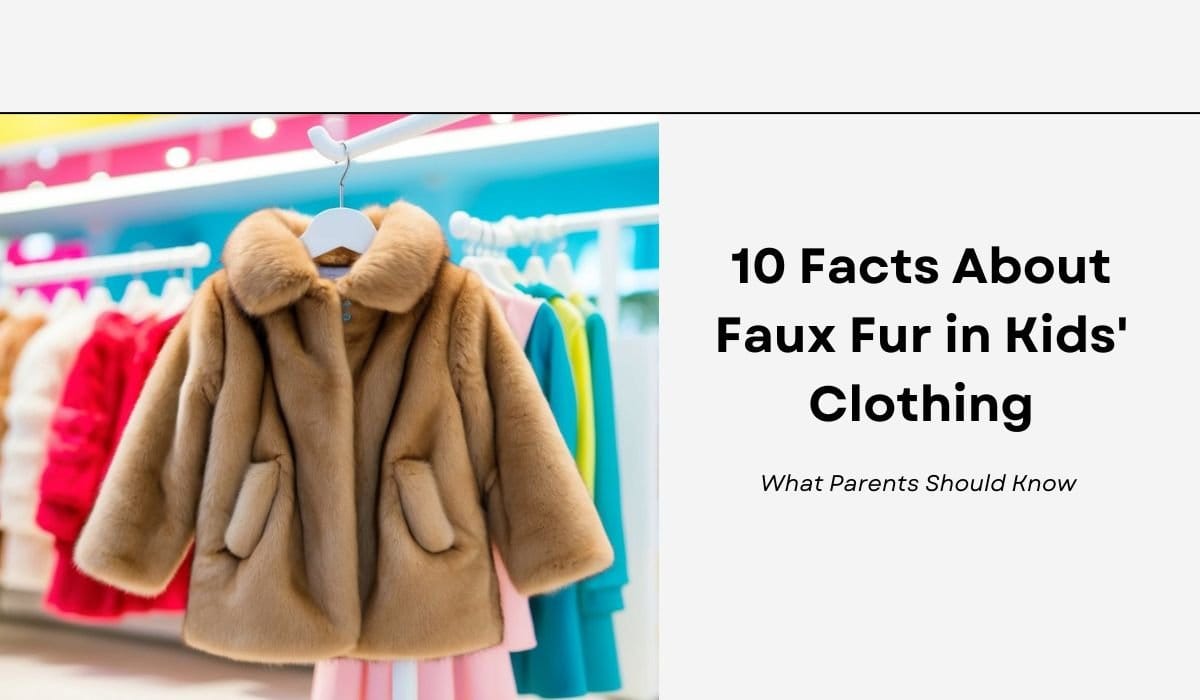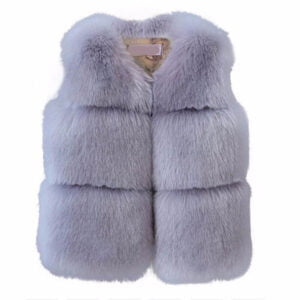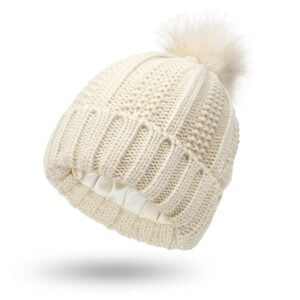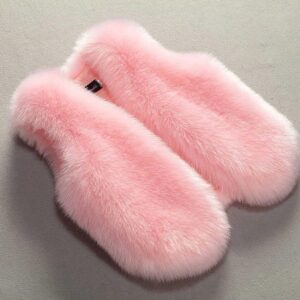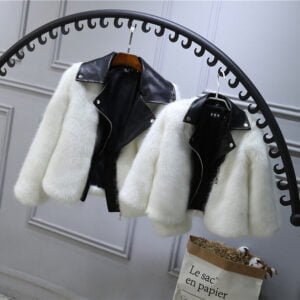From Cosy Comfort to Ethical Fashion: Understanding Children’s Synthetic Fur Choices
Faux fur has become a popular choice for children’s clothing. It offers a soft, warm, and stylish alternative to real fur without harming animals. Parents are increasingly drawn to faux fur for its practicality and ethical appeal.
Faux fur in kids’ clothing is made from synthetic fibres like polyester and acrylic, designed to mimic the look and feel of real animal fur. These materials are spun into fibres much like cotton candy, creating a plush texture that children love. The result is cosy garments that keep little ones warm in chilly weather.
Many fashion brands now offer faux fur options for children. From coats and jackets to hats and accessories, there’s a wide range of choices. These items often come in fun colours and patterns that appeal to kids’ playful tastes.
On This Page
Key Takeaways
- Faux fur offers a cruelty-free alternative to real fur in children’s clothing
- Synthetic fibres are used to create soft, warm garments that mimic animal fur
- Many brands now offer a variety of faux fur clothing options for kids
The Rise of Faux Fur in Fashion
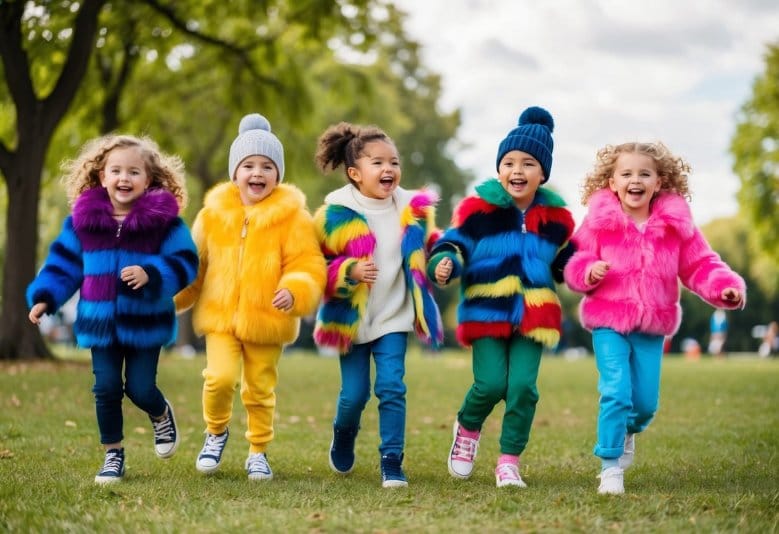
Faux fur has made a big impact on the fashion world. It offers a cruelty-free option that looks stylish and keeps people warm.
History of Faux Fur
Faux fur first appeared after World War II. New fabric technology helped create synthetic fur. Early versions didn’t look very real. They were more like fuzzy toys than actual fur.
In the 1990s, things changed. Top designers started using faux fur that looked much more like the real thing. Brands like Prada made fake fur fashionable.
More recently, anti-fur activism has pushed faux fur into the spotlight. Animal rights groups have made people think twice about wearing real fur. This has helped fake fur become even more popular.
Faux Fur as a Sustainable Fashion Choice
Faux fur is often seen as a better choice for the planet. It doesn’t harm animals like real fur does. But it’s not perfect.
Some types of faux fur can be bad for the environment. They’re made from plastics that don’t break down easily. But not all fake fur is the same.
Many fashion labels now use high-quality faux fur. They say it’s more eco-friendly than real fur. These brands are working to make fake fur that looks good and is kinder to the Earth.
Faux fur has become a big trend in sustainable fashion. It lets people enjoy the look of fur without the ethical worries.
Characteristics of High-Quality Faux Fur
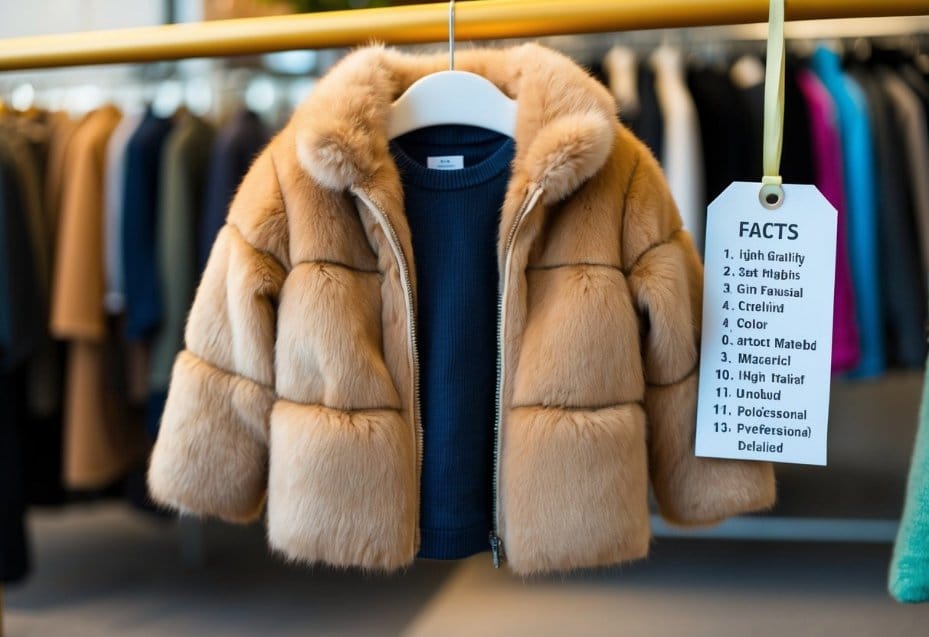
High-quality faux fur offers several key features that make it an excellent choice for children’s clothing. It aims to mimic real fur while providing unique benefits in terms of texture, weight, and durability.
Comparing Textures and Weights
Top-notch faux fur is soft and luxurious, rivalling the feel of genuine fur. It comes in various textures, from silky smooth to fluffy and plush. The weight of high-quality faux fur can vary, with some types being lightweight and others offering more substantial warmth.
Manufacturers often blend different synthetic fibres to achieve the desired texture and weight. This allows for a range of options suitable for various clothing items and seasons.
High-end faux fur typically has a dense pile, creating a rich, full appearance. The fibres are evenly distributed and securely attached to the backing fabric, ensuring a consistent look and feel.
Resilience and Shedding Tendencies
Superior faux fur is durable and resilient, maintaining its shape and texture even after repeated wear and washing. It bounces back quickly when compressed, retaining its original loft and appearance.
Quality fake fur resists matting and tangling, making it easier to care for than real fur. This is particularly important for children’s clothing, which often requires frequent cleaning.
While some shedding is normal, high-quality faux fur sheds minimally. The fibres are securely anchored to the backing, reducing loose strands and maintaining the garment’s appearance over time.
Faux fur’s resilience also means it can withstand rough play and active use, making it ideal for children’s outerwear and accessories. It keeps its shape and texture, ensuring long-lasting comfort and style.
Types of Faux Fur and Their Uses
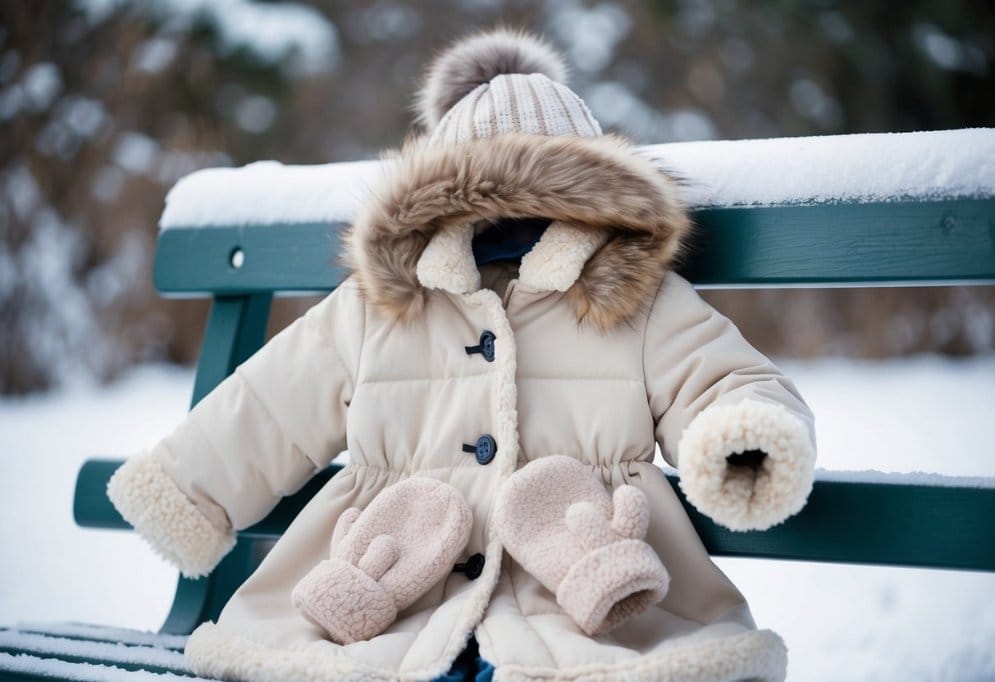
Faux fur comes in various textures and styles to mimic different animal furs. These synthetic alternatives offer warmth and style for children’s clothing without using real animal products.
Short Pile and Medium Pile Variants
Short pile faux fur has a smooth, velvety texture. It’s perfect for jacket collars, cuffs, and trim. This type is easy to clean and maintain, making it ideal for kids’ everyday wear.
Medium pile faux fur has slightly longer fibres. It’s often used for coats and accessories like hats and gloves. This variant provides extra warmth while still being manageable for children to wear.
Both short and medium pile faux furs can imitate various animal textures:
- Beaver: Dense and soft
- Ermine: Sleek and fine
- Marten: Silky and lustrous
These types are versatile and work well for a range of children’s clothing items.
Luxurious Faux Fur Replications
Luxury faux fur aims to replicate high-end animal furs. It’s often used for special occasion wear and statement pieces in children’s fashion.
Popular luxury faux fur types include:
- Chinchilla: Incredibly soft and fluffy
- Sable: Rich and deep
- Lynx: Long and wispy
These faux furs are crafted to look and feel as close to real fur as possible. They’re often used in high-end children’s coats, jackets, and accessories.
Tissavel is a brand known for its premium faux fur. It’s prized for its realistic look and feel, often used in designer children’s clothing.
Leopard print faux fur is a fashionable choice for kids’ clothing. It adds a fun, wild touch to coats and accessories.
The Production of Faux Fur
Faux fur is made from synthetic materials using specialised manufacturing methods. The process involves creating artificial fibres and crafting them into a fabric that mimics real animal fur.
Synthetic Fibres and their Properties
Synthetic fibres used in faux fur production include acrylic, polyester, and modacrylic. Acrylic fibres are soft and warm, making them ideal for imitating fur. Polyester is durable and resistant to wrinkles, while modacrylic offers flame-resistant properties.
These fibres can be engineered to have specific characteristics. Manufacturers can adjust the length, thickness, and texture to replicate different types of animal fur. They can also dye the fibres in a wide range of colours, allowing for more creative designs than natural fur.
Synthetic fibres are lightweight and easy to care for. They dry quickly and retain their shape well after washing. This makes faux fur garments practical for children’s clothing.
Manufacturing Techniques of Faux Fur Fabric
The production of faux fur fabric involves several steps. First, the synthetic fibres are created through a process similar to making cotton candy. The fibres are then attached to a backing material, usually made of polyester or cotton.
Manufacturers use specialised machines to weave or knit the fibres into the backing. They can control the density and direction of the fibres to create different textures and patterns. Some techniques produce a more realistic look, while others focus on softness or durability.
After weaving, the fabric undergoes finishing processes. These may include shearing to achieve a uniform length, brushing to increase softness, and applying treatments for water resistance or colour fastness. The result is a fabric that looks and feels similar to real fur but is entirely artificial.
Faux Fur in Children’s Apparel
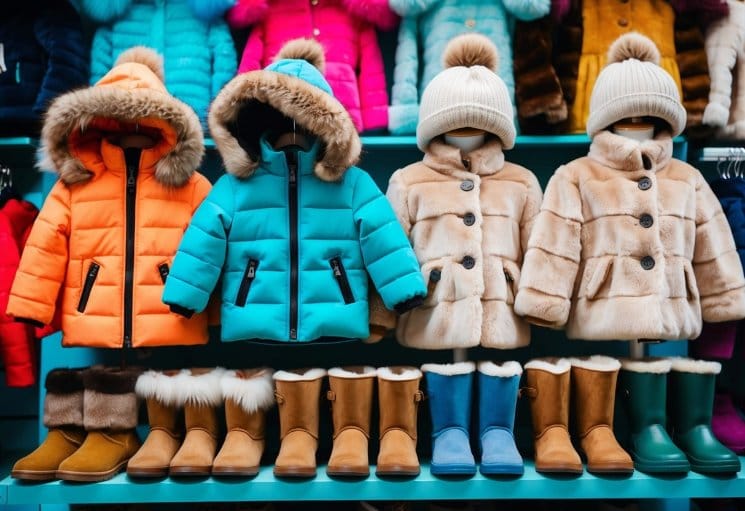
Faux fur has become a popular choice for children’s clothing. It offers a stylish look while being animal-friendly. Many parents are choosing faux fur options for their kids’ wardrobes.
Assessing the Safety and Comfort for Children
Faux fur in children’s clothing is generally safe to wear. Most faux fur fabrics are made from synthetic materials like polyester. These materials are often soft and comfortable against a child’s skin.
It’s important to check the quality of faux fur products. High-quality faux fur should not shed or cause irritation. Parents should look for items with smooth backings and well-secured fur.
Faux fur can be warm, making it great for winter wear. However, it may not be suitable for all weather conditions. It’s best to layer faux fur items for easy temperature control.
Recommended products
Baby faux fur vest for girls – Grey
£19.99Cable knit beanie with faux fur pom – Beige
£9.99Girls faux fur vest – Pink
£18.99Toddler girl faux fur jacket – White
Price range: £41.56 through £42.56
Trendy Faux Fur Clothing for Kids
Children’s faux fur clothing comes in many styles. Faux fur coats and jackets are popular choices for colder months. These items often feature fun colours and patterns that appeal to kids.
Faux fur vests are another trendy option. They can be dressed up or down for different occasions. Some children’s shoes even incorporate faux fur for added warmth and style.
Accessories like faux fur shawls or hats can add a stylish touch to outfits. These items allow kids to try the faux fur trend without committing to a full garment.
Many children’s faux fur items feature animal prints or designs. This allows kids to enjoy animal-inspired fashion without harming real animals.
Ethical and Animal Welfare Considerations
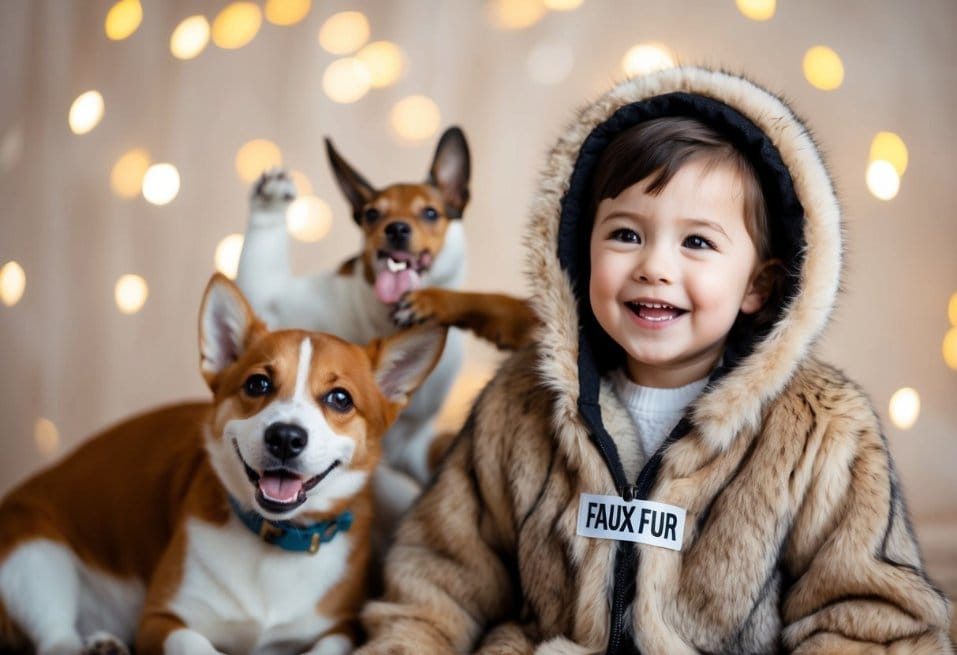
Faux fur in kids’ clothing raises important ethical questions and has sparked action from animal rights groups. The shift towards artificial alternatives reflects growing concern for animal welfare in fashion.
Advocacy by Animal Rights Groups
Animal rights organisations have played a key role in promoting faux fur. Groups like PETA have staged high-profile protests against real fur use in fashion. Their campaigns highlight the harsh conditions on fur farms, where animals often live in small cages.
These groups argue that faux fur offers a cruelty-free option for warm, stylish children’s clothing. They’ve successfully pressured many brands to switch to artificial fur or drop fur entirely.
Animal welfare concerns extend beyond just fur to other animal-derived materials in kids’ fashion. Advocacy efforts have increased awareness about leather, wool, and down production as well.
Ethical Fashion Movement Impact
The ethical fashion movement has embraced faux fur as an animal-friendly alternative. Many eco-conscious brands now use only artificial fur in their children’s lines. This shift reflects growing consumer demand for cruelty-free products.
Faux fur aligns with broader sustainability goals in fashion. It allows for animal-inspired designs without harming animals. However, most faux fur is made from synthetic materials, which raises environmental concerns.
The movement has pushed for transparency in labelling. Some companies have been caught mislabelling real fur as fake. Stricter regulations now help ensure parents can make informed choices about the materials in their children’s clothes.
Caring for Faux Fur Garments
Proper care keeps faux fur soft and fluffy. Regular maintenance and smart storage help these garments last longer.
Maintenance to Preserve Quality and Appearance
Brush faux fur regularly to keep it looking nice. Use a wide-toothed comb or soft brush. Gently detangle any knots.
For cleaning, hand wash or use the gentle cycle. Mix a mild soap in cool water. Dunk the garment and swish it around. Don’t twist or wring it out.
Rinse thoroughly until the water runs clear. Press out excess water with a towel. Don’t use heat to dry. Lay flat or hang to air dry.
Once dry, fluff the fur with your hand or a brush. This helps restore its texture.
Tips for Longevity
Store faux fur items properly when not in use. Keep them in a cool, dry place away from direct sunlight. Use padded hangers to maintain shape.
Avoid crushing faux fur. Don’t stack heavy items on top. If creased, use a steamer to restore the pile. Hold it 15 cm away and steam lightly.
For stubborn odours, try airing out the garment. Hang it outside on a breezy day. Don’t use perfumes or sprays directly on the fur.
When travelling, pack faux fur items in a garment bag. This protects them from damage and dirt.
Frequently Asked Questions
Faux fur in children’s clothing raises several important questions about its environmental impact, use, and characteristics. Parents often want to know more about this popular fabric option for kids’ garments.
What distinguishes faux fur from real fur in terms of environmental impact?
Faux fur is made from synthetic fibres like polyester and acrylic. It doesn’t involve animal products, which reduces ethical concerns.
Faux fur production uses fewer natural resources than raising animals for real fur. But it does rely on petroleum-based materials that aren’t biodegradable.
How has faux fur become integrated into children’s fashion?
Faux fur has gained popularity in kids’ clothing due to its soft texture and fun appearance. It’s used in jackets, hats, and accessories for children.
Many parents choose faux fur as a cruelty-free alternative to real fur. It allows kids to enjoy the look of fur without ethical concerns.
What purposes does faux fur serve in children’s clothing?
Faux fur adds warmth to winter garments like coats and hats. It provides a cosy layer of insulation for children in cold weather.
The material also serves a decorative purpose. It’s used to create cute animal-themed outfits and accessories that appeal to kids.
Can you describe the characteristics and properties of faux fur?
Faux fur is soft, lightweight, and often less expensive than real fur. It comes in a wide range of colours and textures.
The material is generally easy to clean and maintain. It’s more resistant to moisture than real fur, making it practical for children’s clothing.
How do the production processes of faux fur affect ecological sustainability?
Faux fur production involves synthetic materials and chemical processes. This can lead to pollution and energy consumption.
However, faux fur doesn’t require animal farming or the use of harmful preservatives. This can reduce certain environmental impacts compared to real fur.
What are key considerations when selecting faux fur for children’s garments?
Quality is important when choosing faux fur for kids’ clothes. Look for dense, soft fibres that won’t shed easily.
Consider the garment’s intended use. Thicker faux fur is better for warmth, while shorter pile is more suitable for decorative touches.
Related Post: What You Need to Know About Faux Fur

